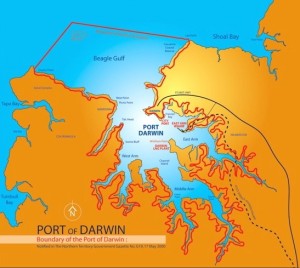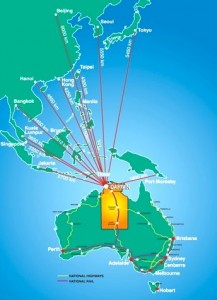11/16/2011 By Robbin Laird and Ed Timperlake
President Obama is focusing on the Pacific this week and he will go to Australia. The President is scheduled to visit with the Australian Prime Minister, and Darwin, a port city, in the Northern Territories. Darwin is the home of many things; among them a forward deployed RAAF base and other military facilities.
The Prime Minister and the President will highlight the coming of the USMC to a training facility in the Northern territories. The visit could be the beginning of a strategic opening for Darwin and the Northern Territories in the 21st Century approach of Australia and its allies to develop realistic training opportunities and thus establish war-deterring con-ops.
Darwin’s strategic location could become a hub of Pacific operations for Australia and a place to visit for its core allies. Singapore, South Korea, Japan, and the United States could all become key members of an Australian-based and Australian run F-35 hub.
Australia rightly wishes to preserve its independence. In being a partner in flying the F-35. The RAAF is joining a FLEET of aircraft –F-35 As, Bs, and Cs, which can be deployed to Australia for training, from bases in Singapore, South Korea, and Japan and off US ships and USAF air bases in the Pacific. The entire allied team can draw upon Australian air modernization to shape new capabilities for Australia, and diversify support for the F-35 multinational fleet.
(For the fleet concept as part of a new Pacific strategy see https://sldinfo.com/special-report-on-crafting-a-new-pacific-strategy/)

The location of Darwin provides a significant location for a hub. For example Pearl Harbor is 6700 miles to both Singapore and Hanian Island and 4,500 miles to South Korea. However, some interesting distances from Darwin allow it to intersect with core allies are as follows:
- From Darwin to tip of South Korea is 3,000 miles–so half way the great circle is over the Philippines
- From Darwin to Singapore is 2000
- From Darwin to Spratley Islands is 1800
- From Darwin to Hanian Island-emerging huge PLAN sub base is 2500
- From Darwin to Jakarta is 1800
- From Darwin to Taiwan is 2400
The RAAF can go from being on their forward deployed airfield to becoming a hub for the F-35 fleet in several ways.
First, given the significant commonality among the three types of F-35s, a significant logistics and support hub can be based in the Northern Territories. The differences among naval air and air force air are significantly blurred by the commonality of the F-35s. This means that specific support for the As, Bs, and Cs could be generated. Based on the earnings from a logistics hub, the Aussies will be able to pay for a significant part of their own fleet modernization.

And a hub is not a permanent base. As an on-call service facility, the various allies can draw upon support when they are working with the Aussies on regional security missions.
Second, Australia has the large territory necessary for Asian F-35 fleets to train. The F-35 is not a replacement tactical aircraft; it is new flying combat system, which will need significant training territory for pilots to learn how to use all of its capabilities. As an aircraft, which has EW, built in, training to do cyber and EW ops are important. As a 5th generation aircraft, the ability to engage “aggressors” and to “defeat” air defense assets requires significant territory over which to operate as well. Instrumented training ranges over Australia and the contiguous ocean is invaluable for building the necessary skills to deter any aggressor.
As an added benefit, the Aussies will be major gainers of revenue from its various allies using the training facilities as well. With the logistics facilities and the training facilities, the F-35 could gain significant cash for the Aussie military modernization efforts.
Thirdly, the F-35 is a significant ISR asset. The Aussies can build ISR collection facilities, which can leverage the entire allied FLEET of F-35s operating in a regional security setting. They can use such facilities to shape an approach to link other allied ISR assets to establish a “honeycomb” network or grid along the Pacific Rim.
Singapore intends to acquire the VSTOL F-35Bs and perhaps put them aboard ships as well, and South Korea might well do the same. By working with Singapore and South Korea, and the Navy/Marine Amphibious Ready Groups, Australia could work on how best to do airfield protection using joint assets such as Aegis and F-35Bs on land in bunkered and EMP shielded revetments in case of severe runway damage.
https://sldinfo.com/the-f-35b-has-a-unique-war-winning-capability/
Such an Australian hub would be a key element in shaping a new Pacific strategy. For the U.S. and its allies crafting a scalable force, which can leverage one another’s assets across the vast expanses of the Pacific, is crucial. Since no platform fights alone, an allied FLEET of F-35s is a key lynchpin for shaping such a scalable force.
And by shaping a mix of hubs and bases, a honeycomb of force capability could be built for US and allied forces. Diversifying the location of hubs, facilities and bases is crucial not only for the US but its allies and partners. Looking at how to leverage new systems to enhance diversification is a key opportunity to deal with the multiplicity of threats in the Pacific and reduce the capability of an aggressor to concentrate force.
Building a hub at Darwin is in the interest of the Aussies, Asian allies and the United States, as all of the core players shape a Pacific strategy appropriate to the 21st century. And it will help amortize the cost of the acquisition of the F-35 by Australia as well as to support modernization of C4ISR capabilities as well.
(For a background piece on the evolving role of the Northern Territories in Australian defense policy see below:
Defence Feasibility Study for Northern Australia
http://www.futuredirections.org.au/publications/northern-australia/30-northern-australia-swa/125-defence-feasibility-study-for-northern-australia.html
Wednesday, 29 June 2011
Background
Defence Minister Stephen Smith last week announced plans to conduct a Force Structure Review to ensure that the Australian Defence Force (ADF) is geopolitically positioned to meet emerging strategic and security issues along the nation’s northern and western coastlines.
Comment
Mr Smith announced that former Defence Department Secretaries Dr Alan Hawke and Mr Ric Smith will head the review; the results are expected to be published in early 2012. The review seeks to ensure that the ADF is adequately positioned to meet forecast challenges, including the rise of the Indian Ocean rim countries, regional humanitarian disasters and the protection of Australia’s massive hydrocarbon reserves. The review could potentially see the relocation of amphibious assault ships, troops and new plans for deploying the future Joint Strike Fighter.
The report will contribute to the forth-coming 2014 Defence White Paper and will consider complementary studies, including an Australia-United States assessment of the joint use of Australian defence facilities, the base consolidation study and the Palmer review of offshore oil and gas facilities.
The ADF is currently positioned primarily to the south and east of the country, with major naval bases in Sydney and Perth, and large army garrisons in Sydney, Brisbane, Townsville, Darwin and a smaller Special Air Service Regiment in Perth. The current structure stems from a post-Cold War Force Structure Review conducted in 1991 that led to the transfer to Darwin of the Army’s 1st Brigade and greater development of Fleet Base West at Garden Island, Western Australia.
ADF assets in northern Australia would bolster resource and energy security and mitigate emerging challenges. Most of Australia’s $200 billion hydrocarbon industry is located off the coasts of Western Australia and the Northern Territory. Liquefied natural gas is forecast to continue to grow as a significant contributor to Australia’s national GDP. Sector profits are projected to hit $18 billion in 2015-2016. A northern-based ADF component would ensure the physical security of oil and gas infrastructure and maintain energy security for Australia and the broader region.
Minister Smith has prudently argued that the defence reassessment is not aimed at countering the modernising Chinese or Indian militaries. Rather, the study aims to assess ADF positioning as a middle power in the geopolitically important Asia-Pacific region. The Defence Minister has contended that Australia has had a long ‘comprehensive bilateral relationship’ with China, including strategic and security matters, and that China is a ‘responsible stakeholder’ in the international environment. It is imperative for regional stability and continued Australian prosperity, that China does not interpret the report as an attempt by the ADF to position itself as a southern bulwark to Chinese ambition, or as a US proxy.
The review was bilaterally welcomed by West Australian politicians and by Future Directions International CEO Major General John Hartley, who told the Sydney Morning Herald that the review reflects WA’s growing position in the ‘national psyche’. Stakeholders involved in the development of the northern regions of the state must develop strategic policy, to capitalise on potential outcomes of the review. A greater military deployment, and the complementary services associated with the sector, would provide economic opportunities beyond minerals and energy, and assist in the realisation of the Pilbara Cities vision. Port Hedland and Karratha must either, pre-empt the findings of the review and attempt to replicate the features that allowed Townsville and Darwin to become defence hubs, or face the possibility of missing out to other towns with a better marketing strategy.
Liam McHugh
Strategic Analyst
FDI Northern Australia and Energy Security Research Programmes
A shorter version of this piece has appeared on AOL Defens
http://defense.aol.com/2011/11/16/a-new-strategic-moment-for-darwin-and-australia/

